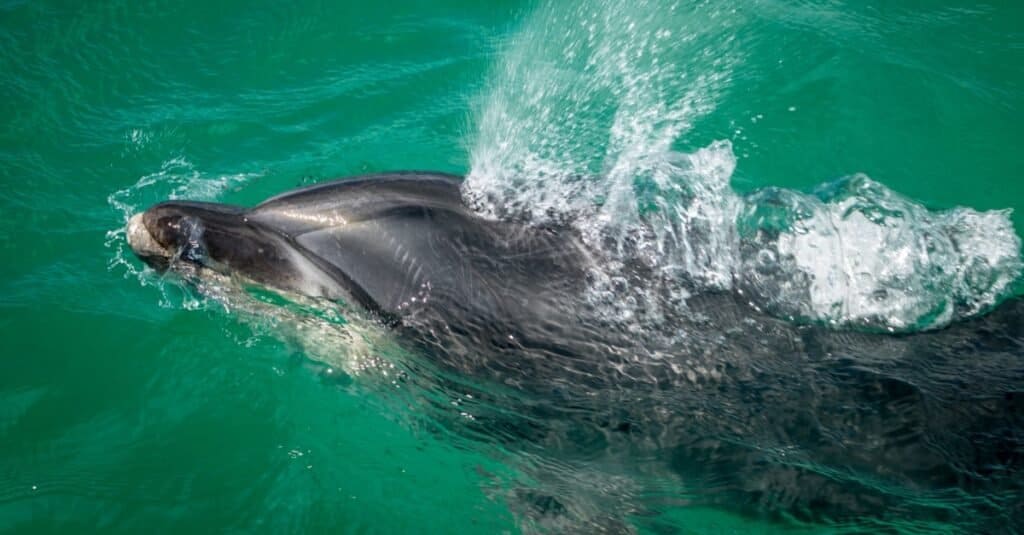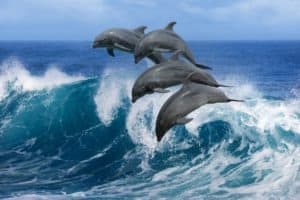Playful, agile, sleek, and compassionate: dolphins have both fascinated and confused people for thousands of years. The Roman author Pliny the Elder, writing around 77 AD, referred to dolphins and whales as fish in his “Natural History” book. While the confusion still runs rampant today, it is actually a wonderful testament to the diversity of the natural world.
Cetaceans are one of the few mammals, along with manatees, that spend their entire lives immersed in the water, never coming up on land. To the extent they resemble fish at all, it’s due to the fact that the torpedo-shaped body, complete with fins and flippers, is one of the fastest and easiest ways to move around in the water. This is an example of convergent evolution: two separate lineages evolving similar characteristics in response to similar environmental pressures.
The dolphin family encompasses a large number of different species, including oceanic dolphins, river dolphins, killer whales, false killer whales, and pilot whales. Today, the closest living relatives of all cetaceans are thought to be the semi-aquatic hippos.
But cetaceans actually evolved from small amphibious mammals around 50 million years ago. The earliest known cetacean ancestor, called the Indohyus, looked a bit like a modern-day mouse deer or chevrotain with long, slender legs and hooves. It also had exceptionally thick bones, which made it possible to wade out into the water and walk on the bottom, where most land animals would struggle to move. By around 40 million years ago, the first fully marine cetaceans evolved. They began to develop streamlined bodies, fins instead of limbs, thick layers of blubber, and other aquatic adaptations. The first true members of the dolphin family emerged some 11 million years ago.
These ancestral origins are enough to classify all dolphins as mammals. But this relationship goes much deeper, all the way down to the dolphin’s anatomy and genes. They bear clear physical hallmarks of the mammalian class, including lungs and milk production. So without further introduction, this article will delve into the top eight characteristics that unite dolphins and other mammals together.
Dolphins breathe through their lungs
If there is a single defining feature that almost all fish, and indeed most marine organisms, share in common (even the so-called lungfish), it’s the gills. These respiratory organs enable them to filter oxygen from the water in order to fully breathe. Dolphins, by contrast, breathe exclusively through their airways and lungs like any land animal. While dolphins have several adaptations to help them hold their breaths for long periods of time in high-pressure underwater environments (including oxygen-rich blood, collapsible lungs, and the ability to slow their heart rates), they must eventually return to the surface after about 10 minutes on average to draw in more oxygen. If they fail to reach the surface in time, then they’ll drown.
The blowhole on the back (which leads to the nasal passage) is the main breathing mechanism. It allows them to expel stale air upward in a gigantic column and then draw in fresh oxygen. When the warm air from the body meets the cold air outside, it condenses into a cloud, which combines with some mucus from the body and the seawater around the hole to form a kind of jet. Since dolphins breathe exclusively through their blowholes, they never have to worry about drawing water into their lungs as they swallow prey. The dolphin’s lungs are also remarkable for their ability to exchange gases. Whereas humans can only exchange 17% of the air in the lungs with every breath, dolphins can exchange a more efficient 80%.

©JoshuaDaniel/Shutterstock.com
Dolphins have a placenta
While internal embryonic development isn’t exclusive to mammals (some fish reproduce this way as well), dolphins have a uniquely mammalian feature that no one else has: the placenta. This temporary organ draws nutrients from the mother’s bloodstream and delivers them to the unborn child. This is an elegant way to ensure the survival of the developing young, but it also places a lot of stress on the mother’s body.
When the mammalian young is finally born after a relatively long gestation period, it is almost always highly developed and partially grown (with the exception of marsupial mammals, which keep their undeveloped young in a pouch). The parents (usually just the mother, but sometimes the father as well) devote a large amount of time and resources to the care of the young, both before and after birth.
Dolphins can produce milk
Like just about all mammals, female dolphins have mammary glands that produce milk for their young. Since the calves have no lips, many of them have to form a water-tight seal by rolling their tongues into a straw-like shape in order to consume the milk while keeping out the seawater. Suckling can often last a few years before the calf is fully weaned from its mother’s milk. Because of the high-calorie content, the milk helps the dolphin build up the blubber it needs to survive in the water.
Calves are born with hair
It’s almost universally true that mammals will grow hair at some point in their lives. Hair provides both warmth and insulation against the surrounding environment. It’s also true that dolphins don’t actually have much need for hair; their blubber beneath the skin provides a nice replacement for the hair’s insulation (as well as buoyancy and protection).
Nevertheless, dolphin calves are born with small follicles or hair protruding from their snouts. This is probably an evolutionary relic without any actual purpose (besides perhaps helping them feel their mother) because most dolphins lose these hairs quickly after birth and never grow a single strand for the rest of their lives. However, the Amazon River dolphin is an exception. It retains the whisker-like hairs into adulthood, perhaps because they provide a useful sensory instrument while the dolphin is foraging in the river mud for something to eat.

©wildestanimal/Shutterstock.com
Dolphins are warm-blooded
The terms “warm-blooded” and “cold-blooded” have long fallen out of favor among biologists (endothermic and ectothermic are now the preferred terms) because they paint a misleading picture of the actual biology. Nevertheless, dolphins are endothermic to their core. They have the ability to maintain and control a healthy body temperature internally, regardless of the outside temperature, via several different mechanisms. “Warm-blooded” organisms have both higher metabolic base rates to produce heat and better means of retaining heat within the body. This is a useful trait shared by modern-day mammals and birds.
Dolphin backbones naturally bend up and down
Many people may not realize that the dolphin’s swimming motion shows clear ancestry with land-based mammals, whose limbs extend underneath their bodies. To increase the length of their gate, land mammals have spines that naturally flex up and down. Whereas fish can bend their tails from side to side, dolphins have evolved the mammal’s natural up and down motion to swim. This also means the tail fin is positioned horizontally instead of vertically. Dolphins have multiple uses for their vertical tail. It’s thought to slap their tails on the water to stun prey and communicate with each other.
Dolphins have a mammalian skeletal structure
While the skeletal structure of a dolphin obviously differs in many respects from your typical land mammal, they also retain many common characteristics, including the presence of three middle ear bones and a vestigial pelvic bone that may play a minor role in supporting the reproductive organs.
Most remarkably of all, the bones of the dolphin’s pectoral (side) fins are roughly analogous to a human arm: they have a humerus bone (with full ball and socket joint) on the upper arm, the ulna and radius of the lower arm, and a complete hand structure with carpal bones and five phalanges (the digits). Of course, the actual shape of these bones is highly modified (the arms are much smaller and the fingers longer), but given the fact that they’re used for completely different reasons and in different environments, the similarities are all the more remarkable.
Another interesting fact about dolphin morphology is that the embryos briefly develop hind limb buds before they’re then absorbed back into the body. This is due to an important limb-forming gene (interestingly, called Sonic Hedgehog, like the video game character) becoming suddenly inactive in the hind limbs during development, which causes them to regress. On very rare occasions, though, the hind limb does not regress, and the dolphin retains two little stubs into adulthood.
Dolphins have larger brains and complex social organizations
While intelligence is hardly an exclusive feature of mammals, they do have a relatively large brain-to-body size, which, it’s theorized, enables them to form complex social organizations, communicate in all kinds of complex ways, and solve complex problems. The dolphin is widely regarded as one of the most intelligent forms of life on the planet.
Dolphins are also great at mimicry, learn quickly, are trainable, and even demonstrate self-awareness. And one of the coolest of their features–they love to play! Dolphins have been observed doing tricks in the wild, riding waves next to human surfers, and even playing games with each other and whales, which are also highly intelligent creatures.
Up Next…
- 10 Incredible Leopard Seal Facts Everything you’ve ever wanted to know and more can be learned in this fun look at the Leopard Seal.
- Puffin vs Penguin: What Are the Differences? Puffins and penguins do bear a striking resemblance in appearance. But how alike are they? Find out how they differ in this article.
- Are Sea Lions Dangerous? Sea lions are adorable with their thick whiskers and are trainable to do tricks for entertainment. So are they dangerous in the wild? Read on to find out.
The photo featured at the top of this post is © Tory Kallman/Shutterstock.com
Thank you for reading! Have some feedback for us? Contact the AZ Animals editorial team.






